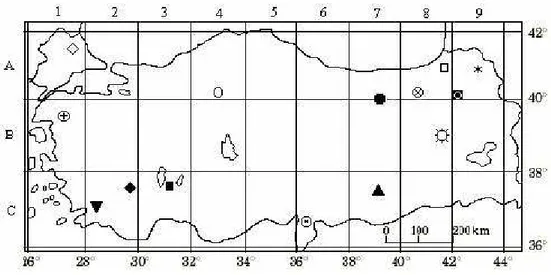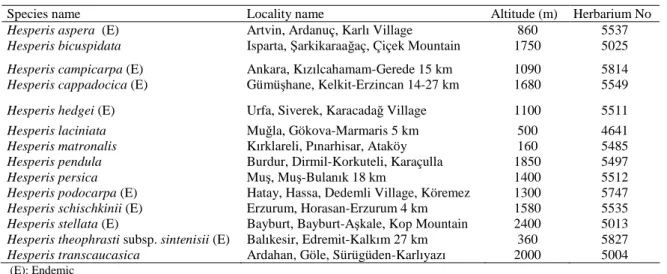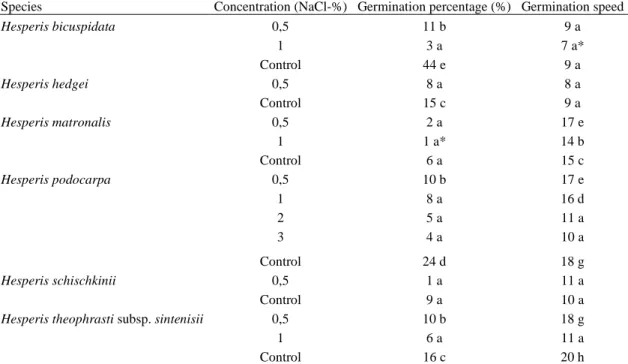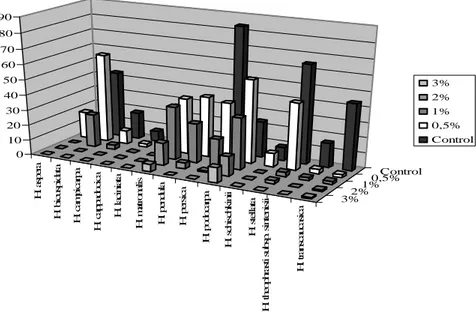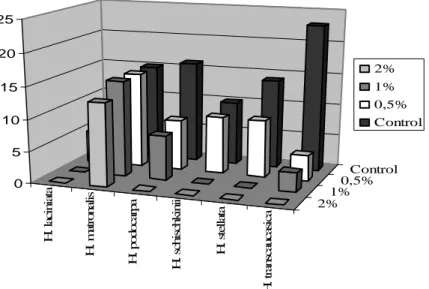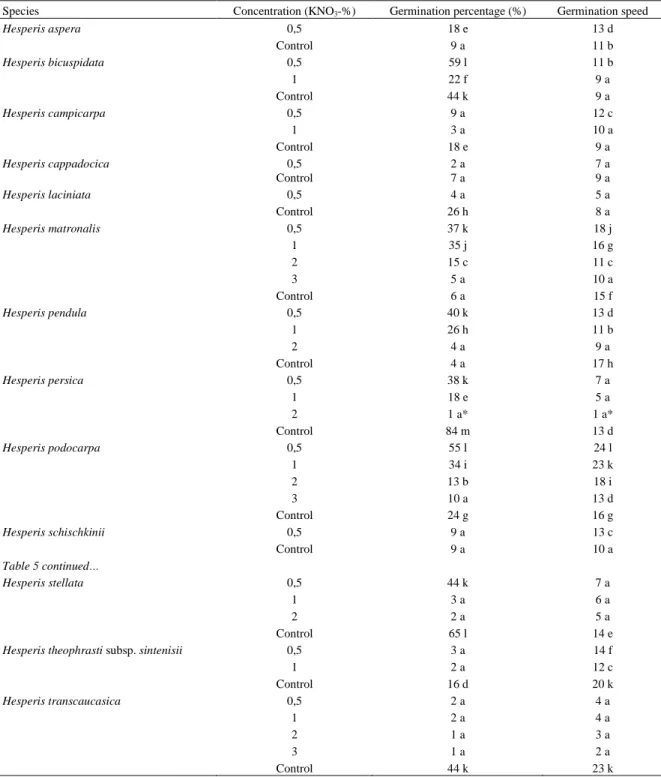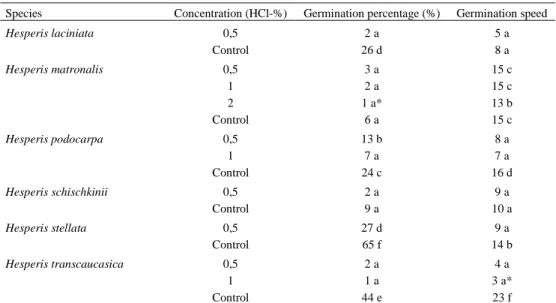BIODICON Biological Diversity and Conservation www.biodicon.com Biyolojik Çeşitlilik ve Koruma ISSN 1308-5301 Print ; ISSN 1308-8084 Online 1 / 2 (2008) 91-104 =====================================================================================
Effects of different salt (NaCl), nitrate (KNO3) and acid (HCl and H2S04) concentrations on the germination of some Hesperis species seeds
Ersin YÜCEL 1, , Ahmet DURAN 2*, Cengiz TÜRE 1, Harun BÖCÜK 1, Burcu ÖZAYDIN 1
1
Anadolu University, Faculty of Science, Department of Biology, Eskişehir, Turkey
2 Selçuk University, Faculty of Education, Department of Biology, 42090 Meram, Konya, Turkey
Abstract
Germination responses of 14 Hesperis species (Hesperis aspera, H. bicuspidata, H. campicarpa, H. cappadocica, H. hedgei, H. laciniata, H. matronalis, H. pendula, H. persica, H. podocarpa, H. schischkinii, H. stellata, H. theophrasti subsp. sintensii, H. transcaucasica) distributing naturally in Turkey were tested in this study at different salt (NaCl), nitrate (KNO3) and acid (HCl, H2SO4) concentrations (Control, 0.5, 1, 2, 3%). Low salt concentration
blocked seed germination of eight taxa (Hesperis aspera, H. campicarpa, H. cappadocica, H. laciniata, H. pendula, H. persica, H. stellata, H. transcaucasica) and also declined seed germination ratio and speed of the others. Although low potassium nitrate concentrations increased germination of all species except H. hedgei, its increasing concentrations decreased it. Hydrochloric acid (HCl) blocked germination percentage and speed completely of eight taxa (Hesperis aspera, H. bicuspidata, H. campicarpa, H. cappadocica, H. hedgei, H. pendula, H. persica, H. theophrastii subsp. sintenisii), while the other six species germinated in its low concentrations. Similarly, sulphuric acid (H2SO4)obstructed
germination of all except two species, H. podocarpa and H. transcaucasica germinated in low H2SO4 concentration.
Significant differences in sensitivity to salt, nitrate and acid were determined among the 14 Hesperis species (p<0.05).
Keywords: Conservation, Ecology, Hesperis, Germination, Turkey
1. Introduction
Physiological responses to various environmental stresses at different stages of their life cycle are an important aspect of explaining adaptation of plants to their habitats. Within this framework, germination is one of the most critical stages in the life cycle of plants and competition in their natural or secondary habitats transported by any vectors (Ungar, 1995; Escudero et al., 1997). In the same way, germination responses have a direct impact on a species’ distribution and abundance, since it is a key element affecting population dynamics (Godi’nez-Alvarez et al., 1999; Valverde et al., 2004; Ramirez-Padilla and Valverde, 2005).
*Corresponding author/Haberleşmeden sorumlu yazar: aduran22@hotmail.com
Genus Hesperis L. (Brassicaceae) distributing on a wide area from Morocco to the Middle East is dense in especially Mediterranean and Irano-Turanian phytogeographic region and has nearly 60 species all over the World (Fournier, 1866; Tzvelev, 1959; Ball, 1993). In Turkey, 31 species and 4 subspecies belonging to the genus were recorded. Moreover, 18 Hesperis taxa are endemic and mostly distributes in the regions belonging to semi-arid and low-precipitation Mediterranean bioclimate layers (Cullen, 1965; 1988; Akman 1990). Considering the fact that Turkey has 35 natural Hesperis taxa of total 60 in the world, it can be thought that Turkey may be genetic differentiation center of the genus.
Some taxa belonging to genus Hesperis can cause economic lost in agricultural areas as weed and damage the natural ecosystem structure in their habitats which they were secondarily transported into by any vector because of their invasive characteristics (Hartman and Nelson, 2000). However, some of them have using potential in medical (as diaphoretic and diuretic) and parfumery sector (Baytop, 1999). Besides, some Hesperis taxa are in a risk category according to IUCN (2001) and considered in conservation programmes.
With the complexity and extensiveness of acid rains, a severe environmental problem in recent years, increased salinity and alkalinity are particularly threatening to Turkey’s soils. So, identifying species resistance to acidity has gained a great amount of importance. Due to increased salinity problem, 0.6% of Turkey’s land is no longer used for cultivation. Therefore, the risk of further salinification and consequent barrenness in currently fertile areas requires serious and urgent consideration. Salt-tolerance in plants may have a direct regulation to growth and it is well known that high salt concentrations inhibit seed germination (Yücel, 2000a). KNO3, a growth-regulating and
germination-stimulating substance, can both stimulate and inhibit seed germination in some species (Öztürk et al., 1984; Öztürk et al., 1993; Puppala and Fowler, 2002).
Some brief information about Hesperis species tested in terms of germination responses to different salt (NaCl), nitrate (KNO3) and acid (HCl and H2SO4) concentrations is given below.
Hesperis aspera Fourn.; stems are erect up to 20 cm in length, with very small and lilac flowers, an endemic plant for Turkey, Hesperis bicuspidata (Willd.) Poiret; stems are (15) 20–35 cm in length, erect, flowers are whitish lilac to deep violet, siliquae slender and torulose; the plant grows over 1300–2800 m, on rocky slopes, a perennial herb. A widespread taxa in Turkey, Hesperis campicarpa Boiss.; stems are branched, flowers are greens to brownish pink, a perennial herb. It grows over 850–1900 m, on rocks and cliffs. An endemic plant for Turkey in CD risk category, Hesperis cappadocica Fourn.; stems are branched from the base, flowers are pinkish-mauve, it grows over 1200-1600 m, on screes, sandy slopes. A biennial herb, an endemic plant for Turkey in LC risk category, Hesperis hedgei P.H. Davis & Kit Tan; stems are approximately 50 cm in length, herbaceous, erect, flowers are lavender. It grows over 1050 m and in basaltic clay fallow fields. It is probably biennial, an Irano-Turanian element, an also endemic plant for Turkey in the EN risk category, Hesperis laciniata All.; it is with yellow or rarely pinkish yellow flowers, siliquae subcompressed, grown on slopes, a biennial herb, Hesperis matronalis L.; stems are up to 100 cm in length, tall, erect siliquae asperous. It grows over 1000–2100 m, on slopes and in meadows, a biennial or rarely a perennial herb. This species has also urinativing, sweating effects and causes to tear down mucus (Baytop, 1999), Hesperis pendula DC.; stems are branched, with greenish-yellow flowers, siliquae terete. The plant grows on fields, gulleys, rocks, usually on limestone, and over 850-2400 m, and it is a perennial plant, Hesperis persica Boiss.; stems are erect, flowers are purple to brownish, and it is a biennial or perennial herb, Hesperis podocarpa Boiss.; stems are up to 40 cm in length, little
branched, flowers are deep violet, siliquae erect. It is a perennial and an endemic plant, Hesperis schischkinii Tzvelev.; stems are erect, up to 30 cm in length, with reddish violet flowers, siliquae terete, obscurely torulose. The plant grows over 1600–2000 m, on igneous slopes and fields. It is a biennial herb and an endemic plant for Turkey in NT risk category, Hesperis stellata Dvořàk; stems are 30–50 cm in length, flowers are deep rose purple or violet. It grows over 2440 m and on rocky slopes. It is perennial plant. This species is an Irano-Turanian element and also endemic plant for Turkey in EN risk category, Hesperis theophrasti Borbàs subsp. sintenisii Dvořàk; stems are 40–48 cm in length, erect, and siliquae torulose, perennial. It grows on marble rocks. It is an East Mediterranean element and an endemic subspecies for Turkey in DD risk category, Hesperis transcaucasica Tzvelev.; stems are tall, erect, the upper stem leaves sessile and amplexicaule, with lilac flowers. It grows over 1700–2250 m, and on rocky slopes, in fields and gullies (Cullen, 1965; 1988; IUCN, 2001), (Figure 1).
It is obvious that determination of the ecophysiological characteristics of the plant taxa, especially endemic and/or in any risk categories is very important for conservation of the biological diversity. No information is available about the ecophysiological characteristics of the genus Hesperis. The aim of this study is, therefore, to determine the effects of different concentrations of salt (NaCl), nitrate (KNO3) and acid (HCl, H2SO4) on the germination of 14
Hesperis taxa distributing naturally in Turkey.
2. Materials and methods
After determined natural distribution areas of 14 Hesperis species in Turkey, seed samples were collected from their natural habitats (Table 1, Figure 1). Plant samples were also taken as herbarium materials, identified and vouchers were kept in the Herbarium of Kırıkkale University (ANADOLU), Faculty of Science and Arts, Department of Biology (Cullen, 1965; 1988).
Figure 1. Seed collection localities (in Turkey)
(□ Hesperis. aspera; ■ H. bicuspidata; ○ H. campicarpa; ● H. cappadocica; ▲ H. hedgei; ▼ H. laciniata; ◊ H. matronalis; ♦ H.
Weight of 1000 dry seeds was determined after the seeds gathered (Table 2). The germination experiments were carried out in plant growth chambers (MLR–350 Model Sony, Japan). During the experiments, a constant temperature (25 0C ± 1) and a white light source (daily photo-period of 8 hours light, 16 hours darkness) were used.
Experiments were carried out in petri dishes (9 cm diameter lined with discs of filter paper) containing filter paper. A hundred seeds were used in each petri, with four replicates for each series and concentrations (4x100) (Willan, 1985). During the germination period, treatments were applied to each experiment series in the same way at the same time. Six main series (NaCl, H2SO4, KNO3, HCl, Dark Medium and Control groups) were prepared for each taxon.
During these experiments, 0.5%, 1%, 2% and 3% solutions of NaCl, H2SO4, KNO3 and HCl were used. For the control
group, pure distilled water was used. Seeds were considered as germinated when the radicle touched the seed bed. Germination speed is as much important as seed germination percentage. So, germination speed was calculated for each series of experiments according to Yücel (2000a). For the statistical evaluation of all data acquired at the end of the germination experiments, SPSS 10.0 (Statistics Package for the Social Science) package program was used and ANOVA Scheffe-F test was applied.
Threatened categories are proposed for endemic and rare Hesperis taxa according to IUCN risk categories (IUCN, 2001). The following abbreviations were used: EN, Endangered, CD, Conservation dependent, NT, Near threatened, LC, Least concern, DD, Data Deficient.
3. Results
3.1. Effects of Different Dark-light Periods on the Germination Percentage and Speed
Light encouraged the germination percentage of Hesperis bicuspidata, whereas it inhibited the germination of H. campicarpa, H. laciniata, H. matronalis, H. pendula, H. podocarpa and H. theophrasti. Results showed that these species germinated higher in dark than in light. It was found that relationship between light and germination ratio of
Table 1. Seed collection localities of Hesperis species (in Turkey)
Species name Locality name Altitude (m) Herbarium No
Hesperis aspera (E) Artvin, Ardanuç, Karlı Village 860 5537 Hesperis bicuspidata Isparta, Şarkikaraağaç, Çiçek Mountain 1750 5025 Hesperis campicarpa (E) Ankara, Kızılcahamam-Gerede 15 km 1090 5814 Hesperis cappadocica (E) Gümüşhane, Kelkit-Erzincan 14-27 km 1680 5549 Hesperis hedgei (E) Urfa, Siverek, Karacadağ Village 1100 5511
Hesperis laciniata Muğla, Gökova-Marmaris 5 km 500 4641
Hesperis matronalis Kırklareli, Pınarhisar, Ataköy 160 5485 Hesperis pendula Burdur, Dirmil-Korkuteli, Karaçulla 1850 5497
Hesperis persica Muş, Muş-Bulanık 18 km 1400 5512
Hesperis podocarpa (E) Hatay, Hassa, Dedemli Village, Köremez 1300 5747 Hesperis schischkinii (E) Erzurum, Horasan-Erzurum 4 km 1580 5535 Hesperis stellata (E) Bayburt, Bayburt-Aşkale, Kop Mountain 2400 5013 Hesperis theophrasti subsp. sintenisii (E) Balıkesir, Edremit-Kalkım 27 km 360 5827 Hesperis transcaucasica Ardahan, Göle, Sürügüden-Karlıyazı 2000 5004 (E): Endemic
Table 2. Weight of 1000 dry seeds of each Hesperis species (E: Endemic)
H. aspera, H. cappadocica, H. hedgei, H. persica, H. schischkinii, H. stellata and H. transcaucasica was statistically insignificant (p<0.05), (Table 3). Light inhibited the germination speed of H. campicarpa, H. cappadocica, H. matronalis, H. pendula, H. podocarpa, H. theophrasti subsp. sintenisii and H. transcaucasica. Effect of light on the germination speed was not significant statistically for H. aspera, H. bicuspidata, H. hedgei, H. laciniata, H. persica, H. schischkinii, H. stellata (p<0.05).
3.2. Effects of Different Salt (NaCl) Concentrations on the Germination Percentage and Germination Speed
Salt inhibited the germination of eight species completely at low concentrations, wheras it decreased the germination ratio of six species. All salt concentrations blocked the germination of eight species completely (Hesperis aspera, H. campicarpa, H. cappadocica, H. laciniata, H. pendula, H. persica, H. stellata and H. transcaucasica) and decreased the germination percentage and speed of six species (H. bicuspidata, H. hedgei, H. matronalis, H. podocarpa, H. schischkinii and H. theophrasti), (Table 4).
Low salt concentration (0.5%) decreased the germination percentage of H. bicuspidata, H. hedgei, H. podocarpa, H. theophrasti whereas its effect on germination percentage of H. matronalis and H. schischkinii was found statistically insignificant (p<0.05), (Figure 2). However, this concentration increased the germination speed of H. matronalis, H. podocarpa and decreased the germination speed of H. theophrasti while its effect on germination speed of H. bicuspidata, H. hedgei and H. schischkinii was found statistically insignificant (p<0.05), (Figure 3).
1% salt solution increased the germination speed of H. bicuspidata, H. podocarpa and H. theophrasti. Its effect on the germination percentage of H. matronalis was significant statistically; even though it caused the germination of the others to be inhibited completely. This concentration increased the germination speed of H. podocarpa, decreased of H. matronalis and H. theophrasti, and its effect on H. bicuspidata was insignificant.
All salt concentrations tested during the study (0.5–3%) decreased germination of H. podocarpa and these results were found significant (p<0.05). H. podocarpa was also the only species which could germinate at all salt concentrations.
Species Weight of 1000 dry seed grain (gr)
Hesperis aspera (E) 1,36
Hesperis bicuspidate 1,95
Hesperis campicarpa (E) 2,85
Hesperis cappadocica (E) 2,65
Hesperis hedgei (E) 3,86
Hesperis laciniata 5,43
Hesperis matronalis 1,13
Hesperis pendula 2,13
Hesperis persica 3,25
Hesperis podocarpa (E) 2,60
Hesperis schischkinii (E) 2,66
Hesperis stellata (E) 2,12
Hesperis theophrasti subsp. sintenisii (E) 1,15
3.3. Effects of Different Potassium Nitrate (KNO3) Concentrations on the Germination Percentage and Germination
Speed
Low KNO3 concentration (0.5%) encouraged the germination of H. aspera, H. bicuspidata, H. matronalis, H.
pendula and H. podocarpa, but decreased the germination of H. campicarpa, H. laciniata, H. persica, H. stellata, H. theophrasti subsp. sintenisii, H. transcaucasica. Effects of this concentration on H. cappadocica and H. schischkinii were insignificant (p<0.05), (Figure 4, 5).
1% KNO3 concentration encouraged the germination percentage of H. matronalis, H. pendula, H. podocarpa;
decreased the germination of H. bicuspidata, H. campicarpa, H. persica, H. stellata, H. theophrasti, H. transcaucasica and inhibited the germination of H. aspera, H. cappadocica, H. laciniata, H. schischkinii completely. This concentration decreased the germination speed of H. pendula, H. persica, H. stellata, H. theophrasti, H. transcaucasica, and encouraged germination speed of H. matronalis, H. podocarpa. The effect on H. bicuspidata and H. campicarpa was found insignificant (p<0.05).
Table 3. Effect of dark versus light on germination percentage (%) and germination speed
Species Dark/Light ** Germination percentage (%) Germination speed
Hesperis aspera Dark 4 a* 9 a
Light 9 a 11 a
Hesperis bicuspidata Dark 19 c 12 a
Light 44 g 9 a
Hesperis campicarpa Dark 22 e 18 c
Light 18 b 9 a
Hesperis cappadocica Dark 5 a 17 b
Light 7 a 9 a
Hesperis hedgei Dark 7 a 7 a*
Light 15 a 9 a
Hesperis laciniata Dark 41 g 8 a
Light 26 f 8 a
Hesperis matronalis Dark 19 c 24 h
Light 6 a 15 a
Hesperis pendula Dark 41 g 20 d
Light 4 a 17 b
Hesperis persica Dark 91 i 10 a
Light 84 i 13 a
Hesperis podocarpa Dark 49 g 21 e
Light 24 f 16 a
Hesperis schischkinii Dark 11 a 13 a
Light 9 a 10 a
Hesperis stellata Dark 67 h 16 a
Light 65 h 14 a
Hesperis theophrasti subsp. sintenisii Dark 21 d 22 f
Light 16 a 20 d
Hesperis transcaucasica Dark 47 g 25 i
Light 44 g 23 g
* Within each column, means with the same letter are not significantly different (p=0,05); ANOVA Scheffe–F test.
Table 4. Effect of NaCl concentration on germination percentage (%) and germination speed
Species Concentration (NaCl-%) Germination percentage (%) Germination speed
Hesperis bicuspidata 0,5 11 b 9 a 1 3 a 7 a* Control 44 e 9 a Hesperis hedgei 0,5 8 a 8 a Control 15 c 9 a Hesperis matronalis 0,5 2 a 17 e 1 1 a* 14 b Control 6 a 15 c Hesperis podocarpa 0,5 10 b 17 e 1 8 a 16 d 2 5 a 11 a 3 4 a 10 a Control 24 d 18 g Hesperis schischkinii 0,5 1 a 11 a Control 9 a 10 a
Hesperis theophrasti subsp. sintenisii 0,5 10 b 18 g
1 6 a 11 a
Control 16 c 20 h
* Within each column, means with the same letter are not significantly different (p=0,05); ANOVA Scheffe–F test.
H . b ic u sp id at a H . h ed g ei H . m at ro n al is H . p o d o ca rp a H .s c h is c h k in ii H . th eo p h ra st i su b sp . si n te n is ii 3%2% 1%0,5% Control 0 10 20 30 40 50 3% 2% 1% 0,5% Control
Figure 2. Effects of NaCl on the germination percentage H . b ic u sp id at a H . h ed g ei H . m at ro n al is H . p o d o ca rp a H .s ch is ch k in ii H . th eo p h ra st i su b sp . si n te n is ii 3% 2% 1%0,5% Control 0 5 10 15 20 3% 2% 1% 0,5% Control
Figure 3. Effects of NaCl on the germination speed
2% KNO3 encouraged the germination percentage of H. matronalis, decreased the germination of H. persica,
H. podocarpa, H. stellata, H. transcaucasica; but, the effect on H. pendula was not significant statistically (p<0.05). This solution increased the germination speed of H. podocarpa, and decreased the germination of H. matronalis, H. pendula, H. persica, H. stellata and H. transcaucasica.
H . as p er a H . b ic u sp id at a H . ca m p ic ar p a H . ca p p ad o ci ca H . la ci n ia ta H . m at ro n al is H . p en d u la H . p er si ca H . p o d o ca rp a H . sc h is ch k in ii H . st el la ta H . th eo p h ra st i su b sp . si n te n is ii H . tr an sc au ca si ca 3%2% 1%0,5% Control 0 10 20 30 40 50 60 70 80 90 3% 2% 1% 0,5% Control
Figure 4. Effects of KNO3 on the germination percentage
3% KNO3 was effective on the germination speed and percentage of all species except H. matronalis. This
concentration decreased the germination speed and percentage of H. podocarpa, H. transcaucasica, and it also inhibited the germination completely of the rest (H. aspera, H. bicuspidata, H. campicarpa, H. cappadocica, H. hedgei, H. laciniata, H. pendula, H. persica, H. schischkinii, H. stellata, H. theophrasti). H. transcaucasica attracts attention as the most resistant species to the KNO3 among the 14 species. All KNO3 concentrations inhibited the germination of
Hesperis hedgei completely (Table 5).
H . as p er a H . b ic u sp id at a H . ca m p ic ar p a H . ca p p ad o ci ca H . la ci n ia ta H . m at ro n al is H . p en d u la H . p er si ca H . p o d o ca rp a H . sc h is ch k in ii H . st el la ta H . th eo p h ra st i su b sp . si n te n is ii H . tr an sc au ca si ca 3%2% 1%0,5% Control 0 5 10 15 20 25 3% 2% 1% 0,5% Control
3.4. Effects of Different Hydrochloride Acid (HCl) Concentrations on the Germination Percentage and Germination Speed
HCl concentrations (0.5-3%) applied during the study inhibited the germination of Hesperis aspera, H. bicuspidata, H. cappadocica, H. campicarpa, H. hedgei, H. pendula, H. persica and H. theophrasti completely. However, it decreased the germination percentage of H. laciniata, H. podocarpa, H. stellata, H. transcaucasica. Effect of 0.5% hydrochloride acid on the germination percentage was insignificant for H. matronalis and H. schischkinii (p<0.05), (Figure 6). H . la ci n ia ta H . m at ro n al is H . p o d o ca rp a H . sc h is ch k in ii H .s te ll at a H . tr an sc au ca si ca 2% 1% 0,5% Control 0 10 20 30 40 50 60 70 2% 1% 0,5% Control
Figure 6. Effects of HCl on the germination percentage
0.5% HCl decreased the germination speed of H. podocarpa, H. stellata and H. transcaucasica. Its effect on the germination speed was insignificant for H. laciniata, H. matronalis and H. schischkinii (Figure 7). All species tested in this study did not germinate in the solution of 2-3 % concentrations of hydrochloride acid (Table 6). Only H. matronalis, H. podocarpa and H. transcaucasica germinated in 1% HCl concentration.
3.5. Effects of Different Sulphuric Acid (H2SO4) Concentrations on Germination Percentage and Germination Speed
It is known that even low H2SO4 concentrations inhibit the germination of the plants (Yücel, 2000a; b; c). In
this study, it was determined that germination of 12 species of total 14 (Hesperis aspera, H. bicuspidata, H. campicarpa, H. cappadocica, H. hedgei, H. laciniata, H. matronalis, H. pendula, H. persica, H. schischkinii, H. stellata and H. theophrasti) was completely blocked. Other two species (H. podocarpa and H. transcaucasica) germinated in only 0.5% H2SO4 (Table 7). In this concentration, germination percentage and speed of these species decreased. The
H . la ci n ia ta H . m at ro n al is H . p o d o ca rp a H . sc h is ch k in ii H . st el la ta H . tr an sc au ca si ca 2% 1%0,5% Control 0 5 10 15 20 25 2% 1% 0,5% Control
Figure 7. Effects of HCl on the germination speed
4. Conclusions and discussion
Seeds are the most important reproductive part responsible from distribution, aggregation and abundance of plant populations (Barrera and Nobel, 2003). Several factors like light, salinity, acidity that regulate seed germination interact in the soil interface (Ungar, 1995; Khan et al., 2000). Most seeds are located near the soil surface where salt and acid concentration changes because of rain and continuous evaporation of soil water (Ungar, 1991), especially in semi-arid environments (Godi’nez-Alvarez et al., 1999; Valverde et al., 2004).
The fact that light and illumination period has a great effect on germination is well known (Smith, 1986). They encourage (Yücel, 1996a) or inhibit (Probert et al., 1986; Yücel, 1996b) the germination of some species. Light period is also effective on the germination of some Hesperis taxa. However, it is seen that Hesperis taxa could tolerate the light effects more than the chemicals applied during the experiments.
Tolerance to salinity during germination period is critical for establishment of plants growing in saline soil of arid regions (Ungar, 1995; El-Keblawy and Al-Rawai, 2005). It has reported that low salt concentration is not effective on the germination of most species (Öztürk et al., 1993; Yücel, 2000a) whereas it inhibits the germination of certain species completely when it is in high concentration (Yücel, 2000b; Khan and Gulzar, 2003). Considering the results, it can be seen that increasing salinity due to natural and/or antropogenic reasons and environmental changes related to salinity can have limited effects on distribution of the populations.
KNO3, a growth-regulating and germination-stimulating substance, can both stimulate seed germination in
some species (Öztürk et al., 1984; Öztürk et al., 1994; Puppala and Fowler, 2002) and also inhibit (Yücel, 1996b).
KNO3 concentration series among the parameters applied during the experiments have the less negative effect
on the seed germination. However, increasing concentrations could block or decrease the germination of some Hesperis taxa.
Table 5. Effects of KNO3 concentrations on germination percentage (%) and germination speed
Species Concentration (KNO3-%) Germination percentage (%) Germination speed
Hesperis aspera 0,5 18 e 13 d Control 9 a 11 b Hesperis bicuspidata 0,5 59 l 11 b 1 22 f 9 a Control 44 k 9 a Hesperis campicarpa 0,5 9 a 12 c 1 3 a 10 a Control 18 e 9 a Hesperis cappadocica 0,5 2 a 7 a Control 7 a 9 a Hesperis laciniata 0,5 4 a 5 a Control 26 h 8 a Hesperis matronalis 0,5 37 k 18 j 1 35 j 16 g 2 15 c 11 c 3 5 a 10 a Control 6 a 15 f Hesperis pendula 0,5 40 k 13 d 1 26 h 11 b 2 4 a 9 a Control 4 a 17 h Hesperis persica 0,5 38 k 7 a 1 18 e 5 a 2 1 a* 1 a* Control 84 m 13 d Hesperis podocarpa 0,5 55 l 24 l 1 34 i 23 k 2 13 b 18 i 3 10 a 13 d Control 24 g 16 g Hesperis schischkinii 0,5 9 a 13 c Control 9 a 10 a Table 5 continued… Hesperis stellata 0,5 44 k 7 a 1 3 a 6 a 2 2 a 5 a Control 65 l 14 e
Hesperis theophrasti subsp. sintenisii 0,5 3 a 14 f
1 2 a 12 c Control 16 d 20 k Hesperis transcaucasica 0,5 2 a 4 a 1 2 a 4 a 2 1 a 3 a 3 1 a 2 a Control 44 k 23 k
* Within each column, means with the same letter are not significantly different (p=0,05); ANOVA Scheffe–F test.
As a result of urbanization and industrialization, acid rains have become an important environmental problem in recent years (Evans, 1982). Because of these factors, a large number of species face with the danger of extinction. So, identifying species resistance to acidity has gained a great amount of important. In this study, it is obvious that increasing acidity inhibits or decreases the seed germination of Hesperis taxa.
Table 6. Effect of HCl concentration on germination percentage (%) and germination speed
Species Concentration (HCl-%) Germination percentage (%) Germination speed
Hesperis laciniata 0,5 2 a 5 a Control 26 d 8 a Hesperis matronalis 0,5 3 a 15 c 1 2 a 15 c 2 1 a* 13 b Control 6 a 15 c Hesperis podocarpa 0,5 13 b 8 a 1 7 a 7 a Control 24 c 16 d Hesperis schischkinii 0,5 2 a 9 a Control 9 a 10 a Hesperis stellata 0,5 27 d 9 a Control 65 f 14 b Hesperis transcaucasica 0,5 2 a 4 a 1 1 a 3 a* Control 44 e 23 f
* Within each column, means with the same letter are not significantly different (p=0,05); ANOVA Scheffe–F test.
H . p o d o c a rp a H . tr a n sc a u c a si c a 0,5% Control 0 10 20 30 40 50 0,5% Control
Figure 8. Effects of H2SO4 on the germination
percentage H . p o d o ca rp a H . tr an sc au ca si ca 0,5% Control 0 5 10 15 20 25 0,5% Control
Figure 9. Effects of H2SO4 on the germination speed
Table 7. Effect of H2SO4 concentration on germination percentage (%) and germination speed
Species Concentration (H2SO4-%) Germination percentage (%) Germination speed Hesperis podocarpa 0,5 2 a 2 a* Control 24 b 16 b Hesperis transcaucasica 0,5 1 a* 4 a Control 44 c 23 c
* Within each column, means with the same letter are not significantly different (p=0,05); ANOVA Scheffe–F test.
In all 14 Hesperis taxa, H. matronalis showed a wider tolerance spectrum to light and chemicals applied during the experiments. This is probably the reason of invasive characteristic of the plant. This species has also using potential
medically because of having urinativing, sweating effects and causing to tear down mucus (Baytop, 1999). As a result, Hesperis species are sensitive to NaCl, KNO3, HCl and H2SO4. It is thought that the information about the
ecophysiological characteristics of Hesperis taxa will serve as a database to improve effective conservation strategies related to the species in a risk category, to control the populations of invasive ones and to cultivate the economically important species.
References
Akman, Y. 1990. Đklim ve Biyoiklim. Palme Yayınları, Ankara, Türkiye.
Ball, P.W. 1993. Cruciferae, pp. 336-337 in Tutin, T.G., Burges, N.A., Chater, A.O., Edmondson, J.R., Heywood, V.H., Moore, D.M., Valentine, D.H., Walters, S.M., Webb, D.A., Flora Europaea, Vol:1, Cambridge University Press. Barrera, E.D., Nobel, P.S. 2003. Physiological ecology of seed germination for the columnar cactus Stenocereus
queretaroensis. Journal of Arid Environments. 53: 297–306.
Baytop, T. 1999. Türkiye’de Bitkiler ile Tedavi: Geçmişte ve Bugün. Nobel Tıp Kitabevleri, Đstanbul, Türkiye.
Cullen, J. 1965. Cruciferae, pp. 452–460 in Davis P. H. (Ed.) Flora of Turkey and the East Aegean Islands, Vol 1. Edinburgh University Press, Edinburgh.
Cullen, J. 1988. Cruciferae, pp. 50–54 in Davis P. H. (Eds) Flora of Turkey and The East Aegean Islands, Vol. 10. Edinburgh University Press, Edinburgh.
El-Keblawy, A., Al-Rawai, A. 2005. Effects of salinity, temperature and light on germination of invasive Prosopis juliflora (Sw.) D.C. Journal of Arid Environments. 61: 555–565.
Escudero, A., Carnes, L.F., Repez-Garcia, F. 1997. Seed germination of gypsophytes and gypsovags in semi-arid central Spain. Journal of Arid Environments. 36: 487–497.
Evans, K.S., 1982. Biological effects of acidity in precipitation on vegetation a review. Experimental Botany. 22: 155-169.
Fournier, M. E. 1866. Monographie du genre Hesperis. Bulletin de la Société Botanique de France 13: 326-362.
Godi’nez-Alvarez, H., Valiente-Banuet, A., Valiente-Banuet, L. 1999. Biotic interactions and the population dynamics of the long-lived columnar cactus Neobuxbaumia tetetzo in the Tehuacan Valley, Mexico. Canadian Journal of Botany. 77: 203–208.
Hartman, R. L., Nelson, B.E. 2000. Working List of Invasive Vascular Plants of Wyoming with Vernacular Names
from Major Works, University of Wyoming: Rocky Mountain Herbarium.
http://www.rmh.uwyo.edu/wyinvasives/wyweeds.pdf.
IUCN Species Survival Commission, 2001. IUCN Red List Categories, approved by the 51st meeting of the IUCN Council. Gland, Switzerland.
Khan, M.A., Gul, B., Weber, D.J. 2000. Germination responses of Salicornia rubra to temperature and salinity. Journal of Arid Environments. 45: 207–214.
Khan, M.A., Gulzar, S. 2003. Germination responses of Sporobolus ioclados: a saline desert grass. Journal of Arid Environments. 53: 387–394.
Öztürk, M., Oflas, S., Mert, H. 1984. Studies on the germination of Inula graveolens (L.) Desf. seeds. Ege Üniversitesi, Faculty of Science Journal B VII: 39–46.
Öztürk, M., Gemici, M., Yılmazer, Ç., Özdemir, F. 1993. Allevition of salinity stress by GA3, Kin and IAA on seed germination of Brassica campestris L. Doga, Turkish Journal of Botany. 17: 47–52.
Puppala, N., Fowler, J.L. 2003. Lesquerella seed pretreatment to improve germination. Industrial Crops and Products. 17 (1): 61-69.
Probert, R.J., Smith, R.D., Birch, P. 1986. Germination responses to light and alternating temperatures in European populations of Dactylis glomerata L.V., The principle components of the alternating temperature requirement. New Phyologist. 102: 123-142.
Ramirez-Padilla, C.A., Valverde, T. 2005. Germination responses of three congeneric cactus species (Neobuxbaumia) with differing degrees of rarity. Journal of Arid Environments. 61: 333–343.
Smith, H. 1986. The perception of light quality, In: Photomorphogenesis in plants, Martinus Nijhoff Publishers, Dordrecht, Boston and Lancaster.
Tzvelev, N. 1959. The Genus Hesperis in U.S.S.R. Not. Syst. Leningrad. 19: 114-155. Ungar, I.A. 1991. Ecophysiology of vascular halophytes. CRC Press, Boca Raton, U.S.A.
Ungar, I.A. 1995. Seed germination and seed-bank ecology in halophytes. In Seed development and germination. Edited by J.Kigel and G. Galili. Marcel Dekker, New York.
Valverde, T., Quijas, S., Lo’pez-Villavicencio, M., Castillo, S. 2004. Population dynamics of Mammillaria magnimamma Haworth (Cactaceae) in a lava-field in Central Mexico. Plant Ecology. 170: 167–184.
Willan, R.L. 1985. A guide to forest seed handling, Food and Agriculture Organization of the United Nations, Rome. Yücel, E., 1996a. Türkiye’nin Ekonomik Değere Sahip Bazı Bitkilerinin Tohum Çimlenme Özellikleri Üzerine Bir
Araştırma, A.Ü. Fen Fakültesi Dergisi. 2: 35–47.
Yücel, E., 1996b. Sideritis germanicopolitana subsp. germanicopolitana ve Sideritis germanicopolitana subsp. viridis’in Tohum Çimlenme Özellikleri Üzerine Bir Araştırma. A.Ü. Fen Fakültesi Dergisi. 2: 61-73.
Yücel, E., 2000a. Effects of different salt (NaCl), nitrate (KNO3) and acid (H2S04) concentrations on the germination of
some Salvia species seeds. Seed Science & Technology. 28: 853–860.
Yücel, E., 2000b. Ecological properties of Pinus nigra ssp. pallasiana var. şeneriana, Silvae Genetica. 49/6: 264-277. Yücel, E., 2000c. Effects of different salt (NaCl), nitrate (KNO3) and acid (H2S04) concentrations on the germination of
Pinus sylvestris ssp. hamata seeds, pp. 129-136 In (Ed.) Gözükırmızı, N., Proceedings of the 2nd Balkan Botanical Congress, Plant of The Balkan Peninsula: Into the Next Millennium Volume II, Istanbul, Turkey.
